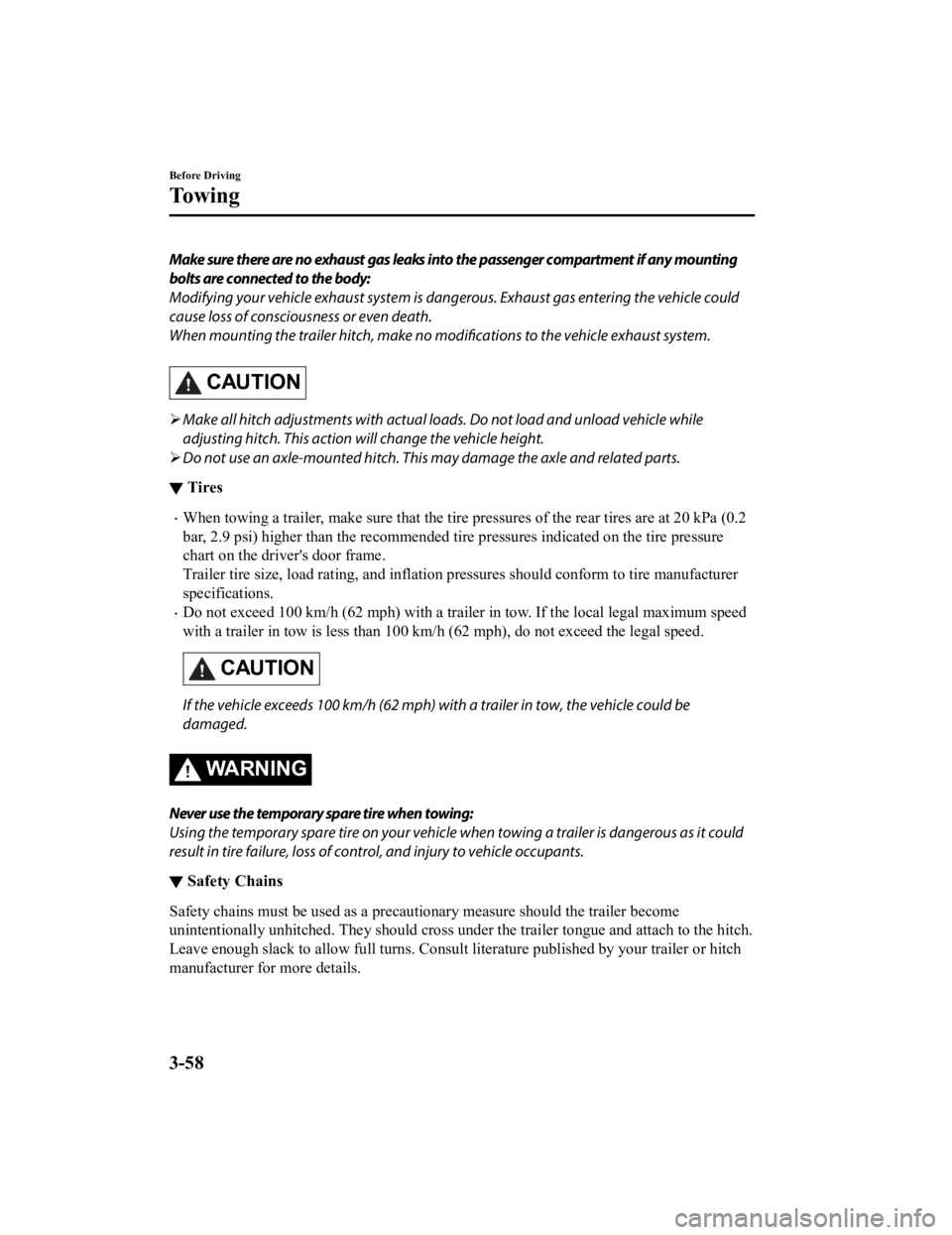tow bar MAZDA CX9 2023 Owners Manual
[x] Cancel search | Manufacturer: MAZDA, Model Year: 2023, Model line: CX9, Model: MAZDA CX9 2023Pages: 739, PDF Size: 11.69 MB
Page 159 of 739

Make sure there are no exhaust gas leaks into the passenger compartment if any mounting
bolts are connected to the body:
Modifying your vehicle exhaust system is dangerous. Exhaust gas entering the vehicle could
cause loss of consciousness or even death.
When mounting the trailer hitch, make no modifications to the vehicle exhaust system.
CAUTION
Make all hitch adjustments with actual loads. Do not load and unload vehicle while
adjusting hitch. This action wi ll change the vehicle height.
Do not use an axle-mounted hitch. This may damage the axle and related parts.
▼ Tires
When towing a trailer, make sure
that the tire pressures of the rear tires are at 20 kPa (0.2
bar, 2.9 psi) higher than the recommended tire pressures indica ted on the tire pressure
chart on the driver's door frame.
Trailer tire size, load rating, and inflation pressures should conform to tire manufacturer
specifications.
Do not exceed 100 km/h (62 mph) w ith a trailer in tow. If the local legal maximum speed
with a trailer in tow is less than 100 km/h (62 mph), do not ex ceed the legal speed.
CAUTION
If the vehicle exceeds 100 km/h (62 mph) with a trailer in tow, the vehicle could be
damaged.
WA R N I N G
Never use the temporary spare tire when towing:
Using the temporary spare tire on your vehicle wh en towing a trailer is dangerous as it could
result in tire failure, loss of control, and injury to vehicle occupants.
▼ Safety Chains
Safety chains must be used as a precautionary measure should th
e trailer become
unintentionally unhitched. They should cross under the trailer tongue and attach to the hitch.
Leave enough slack to allow full turns. Consult literature publ ished by your trailer or hitch
manufacturer for more details.
Before Driving
To w i n g
3-58
CX-9_8LJ2-EA-22H_Edition1_old 2022-6-9 13:33:08
Page 345 of 739

The obstruction is small.
The obstruction is thin such as a signpost.
The obstruction is positioned away from the center of the vehicle.
The surface of the obstruction is not pointed vertically relative to the vehicle.
The obstruction is soft such as a hanging curtain or snow stuck to a vehicle.
The obstruction is shaped irregularly.
The obstruction is extremely close.
In the following cases, the ultrasonic sensors (rear) cannot detect obstructions correctly
and the SCBS R may not operate.
Something is stuck on the bumper near an ultrasonic sensor (rear).
The steering wheel is turned sharply, or the brake or accelerator pedal is operated.
There is another obstruction near one obstruction.
During inclement weather such as rain, fog and snow.
High or low humidity.
High or low temperatures
Strong winds.
The path of travel is not flat.
Heavy luggage is loaded in the luggage compartment or on the rear seat.
Objects such as a wireless antenna, fog light, or illuminated license plate is installed
near an ultrasonic sensor (rear).
The orientation of an ultrasonic sensor (r ear) has deviated for reasons such as a
collision.
The vehicle is affected by other sound wave s such as the horn, engine noise, ultrasonic
sensor of another vehicle.
In the following cases, an ultrasonic sensor (rear) may detect something as a target
obstruction which could cause the SCBS R system to operate.
Driving on a steep slope.
Wheel blocks.
Hanging curtains, gate poles such as at toll gates and railroad crossing.
When traveling near objects such as foliage, barriers, vehicles, walls, and fences along
a road.
When driving off-road in areas where there is grass and forage.
When passing through low gates, narrow gates, car washing machines, and tunnels.
A towing bar is installed or a trailer is connected.
During the SCBS R brake control, the brake pedal may move rearward or become stiff.
The brakes are operating, but continue to depress the brake pedal.
When the system operates, the user is notified by the multi-information display.
The Smart City Brake Support (SCBS) warning indication (amber) turns on when the
system has a malfunction.
Refer to Taking Action on page 7-37.
When Driving
i-ACTIVSENSE
4-180
CX-9_8LJ2-EA-22H_Edition1_old 2022-6-9 13:33:08